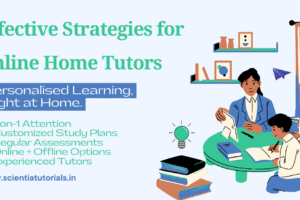Tailoring Your Approach: Teaching Tips for Home Tutors on Adapting Tutoring Styles for Different Age Groups
Introduction
As a home tutor, one of your primary responsibilities is to foster an effective learning environment that meets the unique needs of your students. An essential aspect of this is understanding that different age groups learn differently, requiring distinct tutoring styles and techniques. Adapting your approach not only enhances the educational experience but also helps maintain student engagement and promotes academic success. This article provides valuable insights and practical tips for home tutors on how to adjust their tutoring styles to cater to various age groups effectively.
Understanding Developmental Stages
Before diving into specific tutoring strategies, it’s essential to recognize the developmental stages children go through, as this influences how they learn:
- Early Childhood (Ages 3-5): At this stage, children are highly curious and learn through play and exploration. Their attention spans are short, and they thrive on interactive and hands-on learning.
- Middle Childhood (Ages 6-12): Children begin to develop more complex cognitive skills. They can handle more structured learning but still benefit from engaging and relatable content.
- Adolescence (Ages 13-18): Teenagers are capable of abstract thinking and require more autonomy in their learning. They often seek relevance in what they are studying and are motivated by personal interests.
Understanding these stages will help you tailor your tutoring style to meet the specific needs of your students.
Adapting Tutoring Styles by Age Group
1. Early Childhood (Ages 3-5)
Focus on Play-Based Learning
- Incorporate Games: Use educational games and activities to teach basic concepts. For example, counting games with blocks or alphabet puzzles can make learning fun and interactive.
- Hands-On Activities: Young children learn best through hands-on experiences. Use art supplies for creative projects that reinforce concepts like colors and shapes.
- Storytelling: Engage children with storytelling. Use animated voices and gestures to bring stories to life, helping them develop language skills and comprehension.
Short Sessions
- Limit Session Length: Keep tutoring sessions brief (20-30 minutes) to match their attention span. Frequent breaks can help maintain focus and energy levels.
- Variety is Key: Change activities every few minutes to keep young learners engaged. Rotating between different tasks helps prevent boredom.
Positive Reinforcement
- Encourage with Praise: Use positive reinforcement to build confidence. Celebrate small achievements with praise or stickers to motivate them.
- Create a Reward System: Establish a simple reward system for completing tasks, encouraging children to stay engaged and excited about learning.
2. Middle Childhood (Ages 6-12)
Structured Learning Environment
- Establish Routine: Children in this age group thrive on routine. Create a consistent schedule for tutoring sessions that includes regular breaks to keep them focused.
- Set Clear Objectives: Clearly outline the goals for each session. This provides direction and allows students to understand what they are expected to achieve.
Engaging Content
- Use Relatable Examples: Incorporate real-life examples that are relevant to their interests. For instance, if a student enjoys sports, use sports statistics to teach math concepts.
- Incorporate Technology: Utilize educational apps and online resources that make learning interactive. Websites like Khan Academy and ABCmouse offer engaging content tailored for this age group.
Encourage Critical Thinking
- Problem-Solving Activities: Present problems that require critical thinking and encourage students to come up with solutions. This helps develop analytical skills and fosters independence.
- Group Discussions: Facilitate group discussions on topics of interest. This encourages students to express their ideas and learn from their peers.
3. Adolescence (Ages 13-18)
Foster Independence and Autonomy
- Encourage Self-Directed Learning: Allow students to take the lead in their learning process. Encourage them to set their own goals and find resources to achieve them.
- Facilitate Decision-Making: Involve students in planning their study sessions, allowing them to choose topics or areas they want to focus on.
Relevance to Real Life
- Connect Learning to Interests: Relate academic content to their personal interests and future goals. For example, if a student is interested in a specific career, discuss how their studies apply to that field.
- Discuss Current Events: Engage students in discussions about current events or issues relevant to their lives. This not only promotes critical thinking but also makes learning feel more applicable.
Promote Collaboration
- Group Projects: Encourage collaboration through group projects. Working with peers can enhance social skills and make learning more enjoyable.
- Peer Tutoring: Implement a peer tutoring system where students can teach each other. This reinforces their understanding of the material while building confidence.
Tips for Successful Adaptation
1. Assess Learning Styles
Understanding each student’s learning style is crucial for effective tutoring. Some common learning styles include:
- Visual Learners: Prefer using images, diagrams, and visual aids.
- Auditory Learners: Benefit from listening and discussing material.
- Kinesthetic Learners: Learn best through hands-on experiences and movement.
Use assessments or simple conversations to identify each student’s learning style and adjust your teaching methods accordingly.
2. Build Relationships
Establishing a positive rapport with your students can significantly impact their motivation and willingness to learn:
- Get to Know Your Students: Take the time to learn about their interests, hobbies, and aspirations. This knowledge can help you create more engaging lesson plans.
- Create a Comfortable Environment: Foster a safe and welcoming atmosphere where students feel comfortable expressing themselves and asking questions.
3. Monitor Progress
Regularly assessing your students’ progress allows you to adjust your teaching strategies as needed:
- Frequent Check-Ins: Ask questions and assess understanding throughout the tutoring session. This helps you gauge whether the student is grasping the material.
- Set Milestones: Establish milestones and celebrate achievements. This helps students see their progress and motivates them to keep moving forward.
Conclusion
Adapting tutoring styles for different age groups is essential for fostering an effective learning environment. By understanding the developmental stages of children and teens, home tutors can tailor their approaches to meet the specific needs of their students. Whether using play-based learning for young children, creating structured learning environments for middle childhood, or promoting independence and relevance for adolescents, these strategies can significantly enhance the educational experience.
Incorporating diverse teaching methods, understanding individual learning styles, building relationships, and monitoring progress are all vital components of successful home tutoring. By implementing these teaching tips, tutors can create a more engaging, effective, and fulfilling learning experience that caters to the unique needs of each student, helping them thrive academically and personally.



